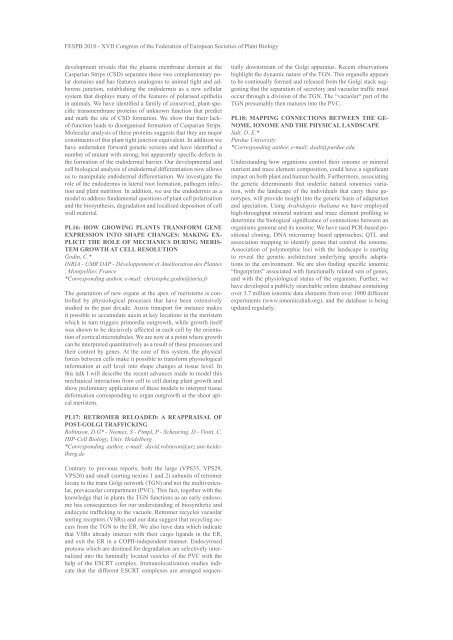Book of Abstracts - Geyseco
Book of Abstracts - Geyseco
Book of Abstracts - Geyseco
You also want an ePaper? Increase the reach of your titles
YUMPU automatically turns print PDFs into web optimized ePapers that Google loves.
FESPB 2010 - XVII Congress <strong>of</strong> the Federation <strong>of</strong> European Societies <strong>of</strong> Plant Biology<br />
development reveals that the plasma membrane domain at the<br />
Casparian Strips (CSD) separates these two complementary polar<br />
domains and has features analogous to animal tight and adherens<br />
junction, establishing the endodermis as a new cellular<br />
system that displays many <strong>of</strong> the features <strong>of</strong> polarised epithelia<br />
in animals. We have identified a family <strong>of</strong> conserved, plant-specific<br />
transmembrane proteins <strong>of</strong> unknown function that predict<br />
and mark the site <strong>of</strong> CSD formation. We show that their lack<strong>of</strong>-function<br />
leads to disorganised formation <strong>of</strong> Casparian Strips.<br />
Molecular analysis <strong>of</strong> these proteins suggests that they are major<br />
constituents <strong>of</strong> this plant tight junction equivalent. In addition we<br />
have undertaken forward genetic screens and have identified a<br />
number <strong>of</strong> mutant with strong, but apparently specific defects in<br />
the formation <strong>of</strong> the endodermal barrier. Our developmental and<br />
cell biological analysis <strong>of</strong> endodermal differentiation now allows<br />
us to manipulate endodermal differentiation. We investigate the<br />
role <strong>of</strong> the endodermis in lateral root formation, pathogen infection<br />
and plant nutrition. In addition, we use the endodermis as a<br />
model to address fundamental questions <strong>of</strong> plant cell polarisation<br />
and the biosynthesis, degradation and localised deposition <strong>of</strong> cell<br />
wall material.<br />
PL16: HOW GROWING PLANTS TRANSFORM GENE<br />
EXPRESSION INTO SHAPE CHANGES: MAKING EX-<br />
PLICIT THE ROLE OF MECHANICS DURING MERIS-<br />
TEM GROWTH AT CELL RESOLUTION<br />
Godin, C.*<br />
INRIA - UMR DAP - Développement et Amélioration des Plantes<br />
, Montpellier, France<br />
*Corresponding author, e-mail: christophe.godin@inria.fr<br />
The generation <strong>of</strong> new organs at the apex <strong>of</strong> meristems is controlled<br />
by physiological processes that have been extensively<br />
studied in the past decade. Auxin transport for instance makes<br />
it possible to accumulate auxin at key locations in the meristem<br />
which in turn triggers primordia outgrowth, while growth itself<br />
was shown to be decisively affected in each cell by the orientation<br />
<strong>of</strong> cortical microtubules. We are now at a point where growth<br />
can be interpreted quantitatively as a result <strong>of</strong> these processes and<br />
their control by genes. At the core <strong>of</strong> this system, the physical<br />
forces between cells make it possible to transform physiological<br />
information at cell level into shape changes at tissue level. In<br />
this talk I will describe the recent advances made to model this<br />
mechanical interaction from cell to cell during plant growth and<br />
show preliminary applications <strong>of</strong> these models to interpret tissue<br />
deformation corresponding to organ outgrowth at the shoot apical<br />
meristem.<br />
Contrary to previous reports, both the large (VPS35, VPS29,<br />
VPS26) and small (sorting nexins 1 and 2) subunits <strong>of</strong> retromer<br />
locate to the trans Golgi network (TGN) and not the multivesicular,<br />
prevacuolar compartment (PVC). This fact, together with the<br />
knowledge that in plants the TGN functions as an early endosome<br />
has consequences for our understanding <strong>of</strong> biosynthetic and<br />
endocytic trafficking to the vacuole. Retromer recycles vacuolar<br />
sorting receptors (VSRs) and our data suggest that recycling occurs<br />
from the TGN to the ER. We also have data which indicate<br />
that VSRs already interact with their cargo ligands in the ER,<br />
and exit the ER in a COPII-independent manner. Endocytosed<br />
proteins which are destined for degradation are selectively internalized<br />
into the luminally located vesicles <strong>of</strong> the PVC with the<br />
help <strong>of</strong> the ESCRT complex. Immunolocalization studies indicate<br />
that the different ESCRT complexes are arranged sequentially<br />
downstream <strong>of</strong> the Golgi apparatus. Recent observations<br />
highlight the dynamic nature <strong>of</strong> the TGN. This organelle appears<br />
to be continually formed and released from the Golgi stack suggesting<br />
that the separation <strong>of</strong> secretory and vacuolar traffic must<br />
occur through a division <strong>of</strong> the TGN. The “vacuolar“ part <strong>of</strong> the<br />
TGN presumably then matures into the PVC.<br />
PL18: MAPPING CONNECTIONS BETWEEN THE GE-<br />
NOME, IONOME AND THE PHYSICAL LANDSCAPE<br />
Salt, D. E.*<br />
Purdue University<br />
*Corresponding author, e-mail: dsalt@purdue.edu<br />
Understanding how organisms control their ionome or mineral<br />
nutrient and trace element composition, could have a significant<br />
impact on both plant and human health. Furthermore, associating<br />
the genetic determinants that underlie natural ionomics variation,<br />
with the landscape <strong>of</strong> the individuals that carry these genotypes,<br />
will provide insight into the genetic basis <strong>of</strong> adaptation<br />
and speciation. Using Arabidopsis thaliana we have employed<br />
high-throughput mineral nutrient and trace element pr<strong>of</strong>iling to<br />
determine the biological significance <strong>of</strong> connections between an<br />
organisms genome and its ionome. We have used PCR-based positional<br />
cloning, DNA microarray based approaches, QTL and<br />
association mapping to identify genes that control the ionome.<br />
Association <strong>of</strong> polymorphic loci with the landscape is starting<br />
to reveal the genetic architecture underlying specific adaptations<br />
to the environment. We are also finding specific ionomic<br />
“fingerprints” associated with functionally related sets <strong>of</strong> genes,<br />
and with the physiological status <strong>of</strong> the organism. Further, we<br />
have developed a publicly searchable online database containing<br />
over 3.7 million ionomic data elements from over 1900 different<br />
experiments (www.ionomicshub.org), and the database is being<br />
updated regularly.<br />
PL17: RETROMER RELOADED: A REAPPRAISAL OF<br />
POST-GOLGI TRAFFICKING<br />
Robinson, D.G* - Niemes, S - Pimpl, P - Scheuring, D - Viotti, C.<br />
HIP-Cell Biology, Univ. Heidelberg<br />
*Corresponding author, e-mail: david.robinson@urz.uni-heidelberg.de
















